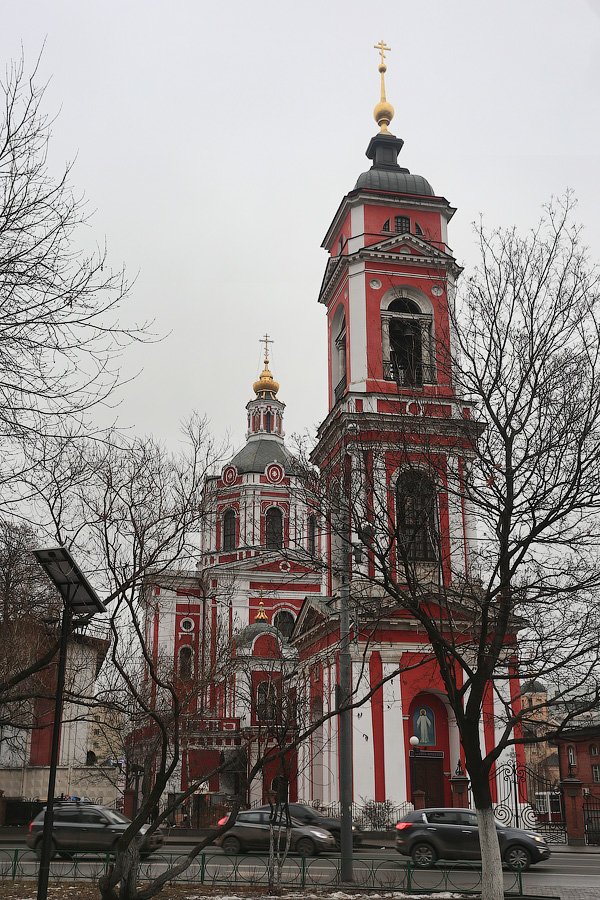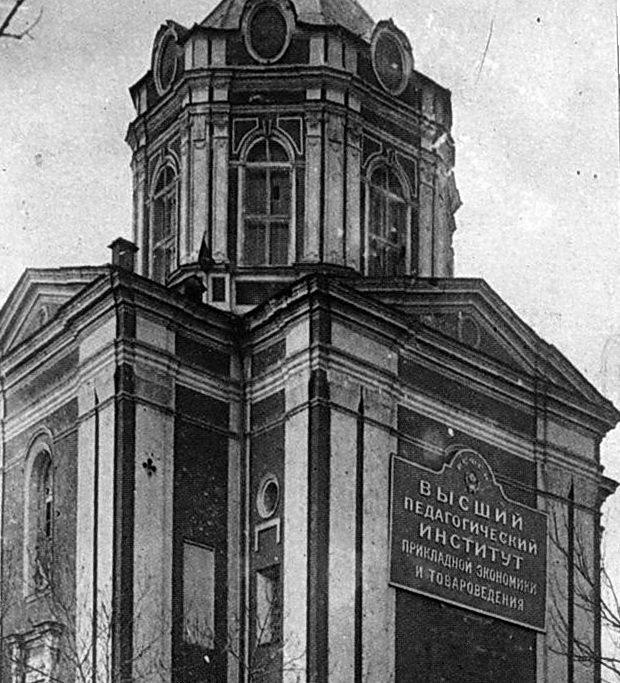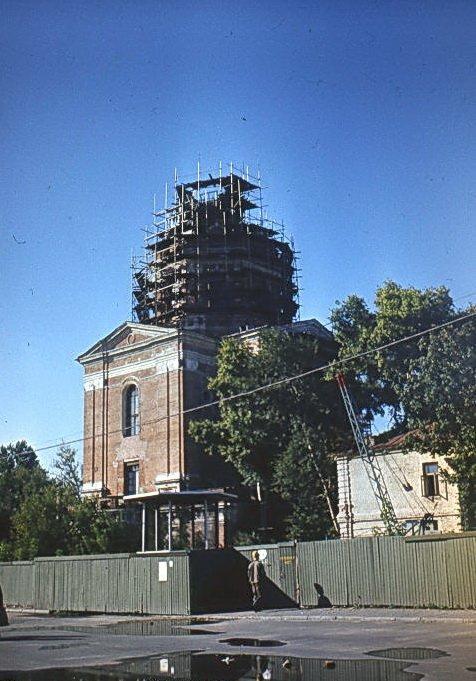В конце XVII в. территория возле Серпуховских ворот активно заселялась ремесленниками и торговцами. Со временем потребовалось строительство отдельного храма для новых жителей. В 1696 г. На пожертвованном Даниловым монастырем участке земли появилась деревянная церковь во имя Вознесения Господня. Но и этот храм оказался недостаточно вместительным: в 1708 г. было выдано разрешение на строительство большого каменного здания эпохи "барокко", причем храмоздателем стал сам царевич Алексей Петрович.
Строительство шло успешно: в 1714 г. был освящен нижний храм во имя Иерусалимской иконы Божией Матери с двумя приделами — Девяти Мучеников Кизических и Алексия Человека Божия (в честь царевича Алексея). Верхняя Вознесенская церковь была построена от сводов до половины окон. Однако вскоре работы оказались прерваны: в 1714 г. вышел указ, запрещавший каменное строительство везде, кроме Санкт-Петербурга. В 1716 г. царевич Алексей тайно бежал в Вену и занял враждебную позицию по отношению к Петру I, в 1718 г. — обманом вывезен в Россию, приговорен к казни и скончался в Петропавловской крепости.
Все эти обстоятельства остановили строительство. Чтобы сохранить построенную часть, прихожане покрыли ее временной деревянной крышей. Лишь в 1762 г. храм был освящен в облике, с изменениями сохранившемся до наших дней.
Зодчим, видимо, был Д. Трезини (Петропавловский собор, Петербург). Называются также имена И.Ф. Мичурина и Д.В. Ухтомского, достраивавших храм. Главный верхний храм на широком гульбище в плане представляет собой крест, завершенный в центре восьмериком с одной главой сложной формы (в эстетике барокко). Фасады оформлены вытянутыми в длину большими окнами, круглыми окошками и пилястрами. Фасады нижнего яруса почти лишены декора. В 1839 г. была сооружена трапезная и при верхнем храме. В 1842 г. над западным входом появилась четырехярусная колокольня с завершением в виде шпиля.
Богослужения здесь продолжались до 1929 г. Храм был закрыт и назначен к сносу. Но разобрали только колокольню и ограду, остальную часть приспособили под склад-холодильник. При этом храм лишился главы с барабаном, был перестроен нижний ярус. Позже здесь было общежитие, конторы, вычислительный центр одного из министерств. Интерьеры были утрачены. Реставрация началась в 1991 г. одновременно с возобновлением богослужений. Специалисты обнаружили под штукатуркой прежние церковные росписи, а из Данилова монастыря доставили Иерусалимскую икону Божией Матери, принадлежавшую церкви. Сегодня храму возвращен облик начала ХХ в., воссозданы глава, колокольня, интерьеры. Рядом построено красивое архитектурное здание детского приюта с домовым храмом во имя Новомучеников и Исповедников Российских. Чуть поодаль возведен храм-часовня во имя равноапостольной княгини Ольги.
Construction process went successfully: in 1714 the lower church was consecrated in the name of Our Lady of Jerusalem with two chapels - Nine Martyrs of Cyzicus and Alexis Man of God (in honor of Prince Alexei ). The Upper Ascension church was built from the vaults to half the windows. However, soon the work was interrupted: in 1714 a decree was issued banning stone construction everywhere except St. Petersburg. In 1716, Tsarevich Alexei secretly fled to Vienna and took a hostile stance towards Peter I, in 1718 - deceived to Russia, sentenced to death and died in the Peter and Paul Fortress.
All these circumstances stopped the construction. To preserve the built part, the parishioners covered it with a temporary wooden roof. Only in 1762 the church was consecrated in the guise, with changes preserved to this day.
Architect D.Trezini ( Peter and Paul Cathedral, St. Petersburg) apparently designed the building. Architects I.F. Michurin and D.V. Ukhtomskii finished the construction of the church building. The main upper temple on a broad gulb in the plan is a cross, completed in the center of the octagon with one chapter of a complex form (in the aesthetics of the Baroque). The facades are decorated with elongated large windows, round windows and pilasters. The facades of the lower tier are almost devoid of decor. In 1839 the refectory was built in the Upper church. In 1842, over the west entrance appeared four-leveled bell tower with completion in the form of a spire.
Worship here continued until 1929. The church was closed and was appointed to the demolition. But only the bell towerand and the fence were dismantled , the rest was used as a refrigerated warehouse. At the same time the temple lost its head with a drum, the lower tier was rebuilt. Later there was a hostel, offices, computer center of one of the ministries. The interiors were lost. Restoration began in 1991 in conjunction with the renewal of worship. They found murals under the plaster of the old church, Jerusalem icon of the Mother of God, which belonged to the church was delivered from the Danilov Monastery. Today, the church returned to face the beginning of the twentieth century. The head, the bell tower and interiors were recreated. A children's shelter home church in the name of the New Martyrs and Confessors Russian is constructed next to the building. A little bit further, a chapel church was erected in the name of the Equal-to-the-Apostles Princess Olga.










%20BEL_0521.jpg&w=1920&q=75)






